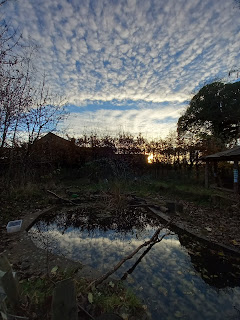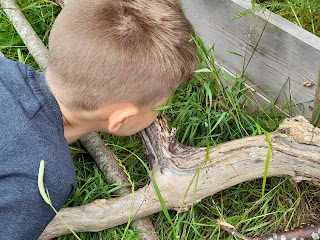Forest School
Since Covid swept the country there has been a focus on getting children outside. This is a great thing. After years of adults complaining sending children outdoors will 'make them sick' the idea that germs cause sickness and not the weather is finally taking hold!
Getting the children outside has led to staggering breaks and lunchtimes, hopefully to more lessons going out into the playground or school garden if they have one. Grab a clipboard and take almost any lesson outside. Get a bit creative and take entire subjects out of the classroom. Use the space to make the learning plan bigger. Assemblies, music, and choirs have all moved out of the building in order to continue - look online and see what has been achieved by relying on outside spaces!
There has been a surge in woodcraft and foraging courses, for adults as well as teachers, forest bathing and outdoor yoga has brought mindfulness back to parks and woodland, camping holidays have never been so popular! The human race is beginning to value being outside, having hobbies outside, and using some of these with either their own children or their classes.
This is all brilliant. The more time we spend in nature the healthier and happier we are, and anything we can do to move the curriculum outside is great for generations of kids.
I've said before that Forest School is just one aspect of Outdoor Learning. No better or worse than the others. But its main difference is its ethos, it is a pedagogy, not a subject. At the end of a group of sessions, there is no assessment on who made what? Who can answer which questions? Who can prove knowledge of specific criteria...?
The 'assessment' is continuous and not formal. Children are encouraged to engage, to explore, to be curious, to bring prior knowledge, to try new things, to gain confidence, to be resilient, to observe, to listen, to work within set parameters, and to take those experiences back into their more formal learning.
If there is an 'outcome' from Forest School sessions it isn't a test about tree identification or recognising bird song, it's evident in children's disposition and self-esteem towards understanding and investigating the world around them.
When it works (and it certainly does more often than not and to varying degrees in each child), teachers in class will notice they have learners with more interest in what they are doing in class, that pupils are more confident in themselves.
Obviously, some Forest School providers create combinations of outside learning WITH Forest School and offer some 'structured' activities within their setting. These are rarely compulsory and are an extra experience the children can choose to join in with if they wish.
For some Forest Schools attached to schools, there is pressure to provide an activity with a set outcome, this can also be dictated in an attempt to ensure sessions are covering part of the curriculum. This can be a very awkward situation for Forest School Leaders. Not only can it mean abandoning the ethos of process over product, but it can narrow the field of that product, and remove the necessity of the child's interest in the activity.
For example, I allow those who want to create wooden 'models' the opportunity to use a hack saw, palm drills, twine, and peelers very independently. They create fishing games, birds, spears, necklaces, mini swings, dragons, lizards, boats...etc.
If I insist every child make a bird (for instance), to fit in with a bird topic in class then I would have to ensure there were enough pieces of wood available of a size and shape that can I deem useful for the task. I may also have to encourage a specific design or process to ensure all 30 children can achieve this activity within the time frame.
We would achieve the learning intention of each child using tools. But we would negate the imagination of the child, the differentiated challenge of looking at a piece of wood and deciding what to create, and the task of seeking out twigs and sticks to add to the structure. We swap chatting about what might work best for following instructions. We lose trying new things until something works in exchange for a set pattern. If we insist on a product they may have no interest in., what happens to the estimating and measuring, the design detail and variation, the plans for use, and the joy of achieving something unique?
The dexterity and fine motor control, as well as the muscle use, required to make
a pre-determined 'bird' are great skills. However, the planning, persistence, trouble-shooting, design, adaptation, discussion, confidence, and self-esteem that comes with the self-chosen task to make whatever you like, are the skills that transfer into all other areas of learning and are the real 'learning intention' of Forest School.
This doesn't mean that I never have an adult-led activity during a session. I have carried out entire sessions with aims and focuses, but I accept that this isn't Forest School, and I don't do it very often. If at all possible this kind of activity is separate from the session. Recently I did a one-off Stone Age Forest School to support the theme in Year 3. The children loved it, and I hope it fed well into their classwork. It would be an amazing asset if such outdoor learning sessions could happen regularly within schools, alongside Forest School and not instead of it.
This week I wanted to create a mini-wildflower garden to attract bees and butterflies. This technically is 'site development' and could be assigned to the premises team, or handed over to an outside company. But I'd much rather do it WITH the children. We had planks, so we built a frame, we filled it with soil, we planted seeds and flowers... Those who wanted to join in did. Some wanted to help with sawing and hammering, others transported soil, many dug and planted.
I have to also point out that if I am tied to one specific activity that makes it impossible to oversee the children engaged in their own child-led tasks. Because I have full classes outside, focusing on a task with just a few means the adult:child ratio goes up. On weeks like this there are a lot of breakages and accidents as children push boundaries and don't get as much reminding about the correct way to use the epuipment. This can be anything from broken garden tools to lost binocular. In all honesty I rarely have an activity that will take up all of my time. I find walking around to see what the children have chosen to do and to joining in is just as effective at moving learning along, extending activities, and teaching skills.
Building a flowerbed definitely needed supervision. If you look carefully at it you can see that I had minimal physical input! Primary children's measuring and making skills are limited!
But across the week everyone had the chance to participate, including helping to fill the bed with soil!
Next week we will hopefully get to plant it up.
Then we wait for the butterflies and bees!











Comments
Post a Comment